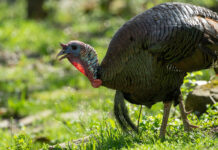Linda and our grandson, Garek, burst into the apartment a few weeks ago excitedly out of breath.
“We’ve got a nest with two white eggs to identify,” she said.
“Sounds like a mourning dove,” I replied.
“But it was on the ground,” Linda answered.
That got my attention. Though mourning doves commonly nest on the ground out west, I had never seen a dove nest on the ground.
Linda pulled out her phone and showed me a photo of two white eggs nestled in a scrape on the ground.
When I asked where they found it, she said Garek almost stepped on it while running down a hill.
A few minutes later they showed me the nest, which was located on a hillside about 20 feet from a sidewalk. An adult sat motionless, incubating the eggs.
Nothing gets children more excited than close encounters with wildlife, so Garek wanted to learn all about these birds.
Mourning doves are one of the most abundant birds in North America.
They occur across Canada, in all lower 48 states and Alaska.
Key to their success is that they are generalists in every sense of the word. They nest from southern Mexico to Alaska.
They eat myriad types of seeds found everywhere — from farms, small towns and parks to vacant city lots, and especially at backyard feeders stocked with white millet, cracked corn and sunflower seeds.
Their nesting habits are equally broad. Here in the east, they build a flimsy platform of twigs in both evergreen and deciduous trees along forest edges, in orchards and backyards.
Seen from below, blue sky often peeks through the nesting materials.
In western deserts and prairies, where trees are often absent, doves are content to nest directly on the ground.
Hence my surprise at finding a nest on the ground in North Carolina.
Furthermore, how can a bird that lays only two eggs per nest maintain a healthy population?
The simple answer is to nest early and often. Pairs bond for the breeding season, which runs from March through September.
In some southern states, they breed all year long. In the East and Midwest, mourning doves usually raise at least three broods per year.
Parents take turns incubating two white eggs for 14 days.
The female warms the eggs from dusk to dawn; the male incubates during the day.
While the young are in the nest, parents feed them “pigeon’s milk,” a pale nutritious liquid that adults produce in their crops (the expanded, food-storage organ above the stomach).
Several times each day, the young induce their parents to regurgitate a helping of pigeon’s milk by reaching into the parent’s mouth to feed.
Young doves leave the nest when about 12 days old, though they often remain in the nest tree for several more days.
When they finally leave the nest tree, they join flocks of other independent juvenile doves.
Though fledglings wear a juvenile plumage, they are difficult to distinguish from adult doves.
That’s why I often hear from readers who ask why they never see “baby doves.”
By the time young doves leave the nest, the parents have already begun another family.
Females often lay eggs in a new nest before the previous brood has left its nest tree.
By producing a series of back-to-back nests, doves multiply rapidly, even though they raise only two chicks in each nest.
After explaining dove natural history to Garek, I told him this nest would probably fail because it was simply too exposed.
Over the next few days, we kept an eye on the nest, which we could see from the street as we drove by.
About a week after Garek and Linda found the nest, the eggs hatched.
Sadly, the chicks disappeared four days later, no doubt victim to a hungry raccoon, opossum, skunk, squirrel, snake, blue jay or crow.
A seed-based diet, general habitat requirements, an extended nesting season and continuous reproduction during the breeding season combine to make mourning doves one of North America’s most common and widely distributed birds.














Have dove nesting on my AC in my coop. Had two eggs. One baby died and is decomposing so I pushed it off AC. Second baby is thriving.
Have many questions but nobody to ask.
Thanks
Mark
I am looking at three young sibling doves being fed by their mother and their nest is on the ground… is that unusual or what?
Hi, …all of a sudden, it started to rain hard ; and, I made a decision to bring him in. So, I placed the bird inside a winter hat inside a shoebox….it is Saturday… I called wildlife to see if I could take him there; but, no one answered… I don’t know what else to do… as far as feeding the bird..?
…all of a sudden, it started to rain hard ; and, I made a decision to bring him in. So, I placed the bird inside a winter hat inside a shoebox….it is Saturday… I called wildlife to see if I could take him there; but, no one answered… I don’t know what else to do… as far as feeding the bird..?
I found a baby dove with feathers on the ground… I waited patiently for couple hours outside to see if his mother would come; but, didn’t happened
Thanks!
Curious as to what you outcome was. It’s 2023 and I just see this post. I could help and yes, I am fully aware of wildlife workers NOT doing their jobs. (Easy paychecks huh?) I was victim of same issue but my baby’s were less than 24hrs hatched. They fell off the side of my house from 20′ above. One passed two days later as Mom pecked it. I fed the remaining dove, a female, “EXACT” that I purchased from a pet supply store and I used a spoon. They don’t open their beaks but rather use it like a straw to suck up the warm grule. So she was spoon fed every two hours around the clock without fail!! If her crop wasn’t full… I wasn’t finished feeding her. She decided when he’d had enough. Yes, a female… she’s thriving well, spoiled rotten and living an amazing life. I fed her every two hours when she was first rescued until was able to peck bird seed from the ground on her own. Yes, very demanding and she came first! I even took her with us if I was going to be gone past her feeding time. Taking her with me/us, in a towel lined tote that i kept covered. I also have a heating pad with a two hour shutoff bypass. That’s in a small 15″× 13″ bird cage and covered with a paper towel. I change that daily and usually before her sundown bedtime. She flies my neighborhood for hours, and has been gone for 24hrs one time when she narrowly escaped a Hawk. But.. she always returns, landing on my head, my back if I’m bent over pulling weeds or gardening. I won’t go into more detail but not a court in the land would convict me about this little lady. I’d gladly hire an attorney! I haveckept strick records of hervalmost daily. Almost a year old now, she is a member of our family, free flying, multi seed eating, bath taking, and the biggest talker and clown you’ve ever seen! I’ve done more research on Mourning Doves and compared to my own knowledge and I can tell you… not all you read is true. One thing is for sure, from someone who never liked Mourning Doves, I am the biggest advocate for their safety and care than any conservationist you’ll ever meet! She’s my girl, we’re a team. My hubby went from “Dove hunter” to “Dove cuddler” in one year. He loves this bird as much as I do. Even checking on her with our security cameras when we leave! Lol! She will be a educational bird, as she already has been. And, she will continue to be a joy and free-flyer in safety zones. I refuse to allow predators to get a hold of her. One close call was enough. For this, she could be 20 yrs old before her charmed life if over. If she brings home a husband, so be it, but solar, it’s a nuns life for her. Her choice! (And I’m Protestant!)
Amazing story! I love my mourning doves. I have two pair that come to visit me everyday. They are so polite and gentle. They will often wait for smaller birds to eat around my feeding center then approach when the other birds are done. I feel so happy and proud that they know my yard is a safety zone for them.
To Greta’ Mom
Thank you very much for sharing that lovely baby dove experience. God has blessed you for your Good Samaritan act by providing you an unexpected friend for life. Live long and prosper.
Try to feed the baby dove with a larger sized straw. A bit of oatmeal can be ground up using a ninja or similar machine. Put a little bit of whipped up egg and milk with the oats to make a mixture that will easily go through the straw. Warm it up slightly and see if the dove can drink it. The mixture should be fairly thick but not too thick. I hope this helps. The dove should be able to fit the beak into the straw and open its beak enough to swallow.
To Greta’s mom: Amazing!! We so admire your devotion to your baby girl! What a lovely, and educational, account of your care and the young dove’s wonderful life. We have an adult pair that nests in a sturdy nest I prepared for them hanging from the eaves, in our courtyard. And now a pair of fledglings. They flew this morning for the first time.
Can a dobe move her eggs before their hatched? And if so how do they move the eggs and why do they move the eggs?
I have a hanging nest under an eve in my back yard. Doves come every year an̈d this year they are on their 3rd round of hatchling. Maybe another week to go before they hatch. Fun watching them from afar.
Thanks for your information. There is a dove nesting in a chainlink arbor (purple vine beans and blue morning glories) outside my bedroom window. Just a few sticks on the mesh and dove. A while back I saw one white egg. It has hatched and baby is almost as big as parent. Baby fluttered wings yesterday. I want to be sure baby is safe from my cats who hunt mice in that same yard. I’ll keep cats inside another day till I see no one in the nest. Baby seems more developed than robin or starling babies that need several days to run the ground before being abe to fly. I depend on the cats to keep farm mice and chipmunks out of the kitchen, and value myriad of birds to keep the flying things out too.